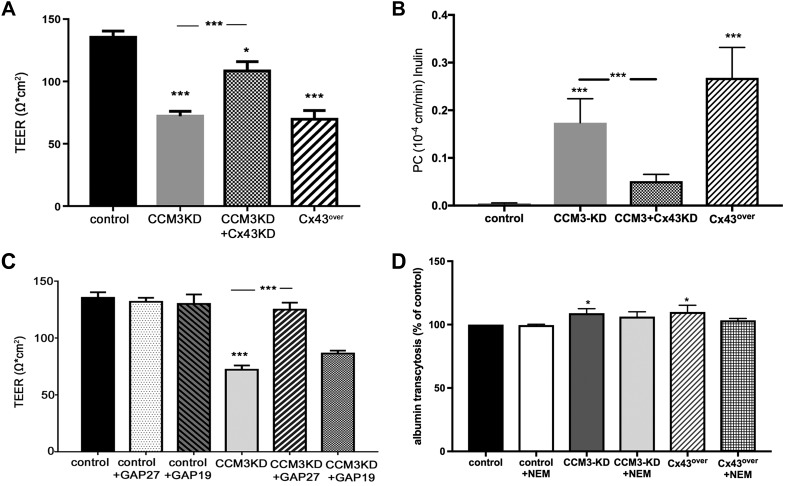Figure 4.
Depletion of Cx43 protein and GAP27-mediated inhibition of Cx43 GJIC rescues CCM3KD monolayer permeability. A) Transwell TEER assays revealed a significant increase in CCM3KD permeability and partial, significant rescue after the reduction of Cx43 expression in CCM3KD cells via Cx43 siRNA-mediated KD. Data represent means ± sem (n = 3–10 independent experiments). *P < 0.05, ***P < 0.0001 compared with control, ***P < 0.001 compared with CCM3KD. Cx43 + CCM3KD efficiency is reported in Supplemental Fig. 2. B) Permeability coefficient (PC) of inulin (MW = 5 kDa) shows increased permeability of CCM3KD and Cx43over mBEC monolayers, whereas the depletion of Cx43 via siRNA rescued mBEC monolayer integrity. Data represent means ± sem. ***P < 0.001 compared with control, ***P < 0.001 compared with CCM3KD. C) Transwell TEER assays performed with control and CCM3KD cells treated with 100 μm GAP19 or 100 μM GAP27 for 24 h. Treatment with GAP27 completely rescued CCM3KD permeability. GAP19 treatment had no effect (n = 3–10 independent experiments). ***P < 0.0001 compared with control or CCM3KD. D) Transendothelial albumin permeability was only slightly increased in CCM3KD and Cx43over monolayers compared with control. Inhibition of vesicular transport with N-ethylmaleimide (NEM) did not disturb the albumin monolayer permeability, which indicated that CCM3 and Cx43 predominantly regulate paracellular permeability. Data represent means ± sem. *P < 0.05 compared with control.

